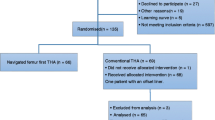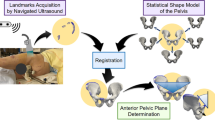Abstract
Purpose
The aim of this study was to validate the accuracy and reproducibility of a statistical shape model-based 2D/3D reconstruction method for determining cup orientation after total hip arthroplasty. With a statistical shape model, this method allows reconstructing a patient-specific 3D-model of the pelvis from a standard AP X-ray radiograph. Cup orientation (inclination and anteversion) is then calculated with respect to the anterior pelvic plane that is derived from the reconstructed model.
Materials and methods
The validation study was conducted retrospectively on datasets of 29 patients (31 hips). Among them, there were 15 men (15 hips) and 14 women (16 hips). The average age of the patients was 69.4±8.5 (49−82) years. Each dataset has one postoperative X-ray radiograph and one postoperative CT scan. The postoperative CT scan for each patient was used to establish the ground truth for the cup orientation. The cup anteversion and inclination that were calculated from the 2D/3D reconstruction method were compared to the associated ground truth. To validate reproducibility and reliability, two observers performed measurements for each dataset twice in order to measure the reproducibility and the reliability of the 2D/3D reconstruction method.
Results
Our validation study demonstrated a mean accuracy of 0.4 ± 1.8° (−2.6° to 3.3°) for inclination and a mean accuracy of 0.6±1.5° (−2.0° to 3.9°) for anteversion. Through the Bland-Altman analysis, no systematic errors in accuracy were detected. The method showed very good consistency for both parameters.
Conclusions
Our validation results demonstrate that the statistical shape model-based 2D/3D reconstruction-based method is an accurate, consistent, and reproducible technique to measure cup orientation from postoperative X-ray radiographs. The best results were achieved with radiographs including the bilateral anterior superior iliac spines and the cranial part of non-fractured pelvises.
Similar content being viewed by others
References
Ali Kahn MA, Brakenbury PH, Reynolds IS (1981) Dislocation following total hip replacement. J Bone Joint Surg Br 63(B): 214–218
McCollum DE, Gray WJG (1990) Dislocation after total hip arthroplasty. Causes and prevention. Clin Orthop 261: 159–170
Sarmiento A, Ebramzadeh E, Gogan WJ, McKellop HA (1990) Cup containment and orientation in cemented total hip arthroplasties. J Bone Joint Surg Br 72: 996–1002
Bader RJ, Steinhauser E, Willmann G, Gradinger R (2001) The effects of implant position, design and wear on the range of motion after total hip arthroplasty. Hip Int 11: 80–90
Lewinnek GE, Lewis JL, Tarr R, Compere CL, Zimmerman JR (1978) Dislocations after total hip-replacement arthroplasties. J Bone Joint Surg Am 60: 217–220
Patil S, Bergula A, Chen PC, Colwell CW Jr, D’Lima DD (2003) Polyethylene wear and acetabular component orientation. J Bone Joint Surg Am 85: 56–63
Widmer KH (2007) Containment versus impingement: finding a compromise for cup placement in total hip arthroplasty. Int Orthop 31(suppl 1): S29–S33
Kalteis T, Handel M, Herold T, Perlick L, Paetzel C, Grifka J (2006) Position of the acetabular cup-accuracy of radiographic calculation compared to CT-based measurement. Eur J Radiol 58: 294–300
Marx A, Knoch M, Pförtner J, Wiese M, Saxler G (2006) Misinterpretation of cup anteversion in total hip arthroplasty using planar radiography. Arch Orthop Trauma Surg 126: 487–492
Tannast M, Zheng G, Anderegg C et al (2005) Tilt and rotation correction of acetabular version on pelvic radiographs. Clin Orthop 438: 182–190
Pradhan R (1999) Planar anteversion of the acetabular cup as determined from plain anteroposterior radiographs. J Bone Joint Surg Br 81(B): 431–435
Widmer KH (2004) A simplified method to determine acetabular cup anteversion from plain radiographs. J Arthroplasty 19: 387–390
Della Valle CJ, Kaplan K, Jazrawi A, Ahmed S, Jaffe WL (2004) Primary total hip arthroplasty with a flanged, cemented all-polyethylene acetabular component: evaluation at a minimum of 20 years. J Arthroplasty 19: 23–26
Arai N, Nakamura S, Matsushita T, Suzuki S (2010) Minimal radiation dose computed tomography for measurement of cup orientation in total hip arthroplasty. J Arthroplasty 25: 263–267
LaRose D, Cassenti L, Jaramaz B, Moody JE, Kanade T, DiGioia AM (2000) Post-operative measurement of acetabular cup position using X-ray/CT registration. In: Proceedings of the 3rd international conference on medical image computing and computer-assisted intervention (MICCAI), LNCS 1935, 1104–1113
Blendea S, Eckman K, Jaramaz B, Levison TJ, DiGioia AM (2005) Measurements of acetabular cup position and pelvic spatial orientation after total hip arthroplasty using computed tomography/radiography matching. Comput Aided Surg 10: 37–43
Jaramaz B, Eckman K (2006) 2D/3D registration for measurement of implant alignment after total hip replacement. In: Proceedings of the 9th international conference on medical image computing and computer-assisted intervention (MICCAI), LNCS 4191, 653–661
Penney GP, Edwards PJ, Hipwell JH, Slomczykowski M, Revie I, Hawkes DJ (2007) Postoperative calculation of acetabular cup position using 2D-3D registration. IEEE Trans Biomed Eng 54: 1342–1348
Zheng G, Steppacher S, Zhang X, Tannast M (2007) Precise estimation of postoperative cup alignment from single standard X-ray radiograph with gonadal shielding. In: Proceedings of 2007 international conference on medical image computing and computer assisted intervention (MICCAI), LNCS 4792, 951–959
Zheng G, Zhang X (2010) Computer assisted determination of acetabular cup orientation using 2D-3D image registration. Int J CARS 5: 437–447
Steppacher SD, Tannast M, Zheng G et al (2009) Validation of a new method for determination of cup orientation in THA. J Orthop Res 27: 1583–1588
Jaramaz B, DiGioia AM, Blackwell M, Nikou C (1998) Computer assisted measurement of cup placement in total hip replacement. Clin Orthop 354: 70–81
Tannast M, Langlotz U, Siebenrock KA, Wiese M, Bernsmann K, Langlotz F (2005) Anatomical referencing of cup orientation in total hip arthroplasty. Clin Orthop 436: 144–150
Langlotz U, Grützner PA, Bernsmann K et al (2007) Accuracy considerations in navigated cup placement for THR. Proc Inst Mech Eng [H] 221: 739–753
Zheng G (2009) Statistically deformable 2D/3D registration for accurate determination of post-operative cup orientation from single standard X-ray radiograph. In: Proceedings of the 12th international conference on medical image computing and computer-assisted intervention (MICCAI), LNCS 5761, 820–827
Zheng G (2010) Statistically deformable 2D/3D registration for estimating post-operative cup orientation from a single standard AP X-ray radiograph. Ann Biomed Eng 38(9): 2910–2927
Seradge H, Nagle KR, Miller RJ (1982) Analysis of version in the acetabular cup. Clin Orthop 166: 152–157
Bland JM, Altman DG (1996) Measurement error and correlation coefficients. BMJ 313(7048): 41–42
Bland JM, Altman DG (1986) Statistical methods for assessing agreement between two methods of clinical measurement. Lancet 1(8476): 307–310
Tannast M, Mistry S, Steppacher SD et al (2008) Radiographic analysis of femoroacetabular impingement with Hip2Norm—reliable and validated. J Orthop Res 26: 1199–1205
Lin F, Lim D, Wixson RL, Milos S, Hendrix RW, Makhsous M (2008) Validation of a computer navigation system and a CT method for determination of the orientation of implanted acetabular cup in total hip arthroplasty: a cadaver study. Clin Biomech 23: 1004–1011
Beckmann J, Lüring C, Tingart M, Anders S, Grifka J, Köck FX (2009) Cup positioning in THA: current status and pitfalls. A systematic evaluation of the literature. Arch Othop Trauma Surg 129: 863–872
Author information
Authors and Affiliations
Corresponding author
Rights and permissions
About this article
Cite this article
Zheng, G., von Recum, J., Nolte, LP. et al. Validation of a statistical shape model-based 2D/3D reconstruction method for determination of cup orientation after THA. Int J CARS 7, 225–231 (2012). https://doi.org/10.1007/s11548-011-0644-7
Received:
Accepted:
Published:
Issue Date:
DOI: https://doi.org/10.1007/s11548-011-0644-7




